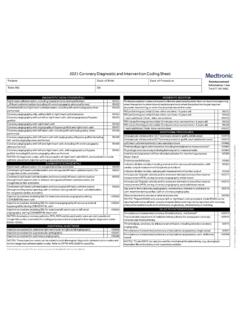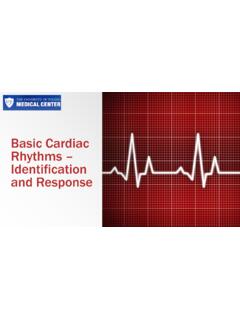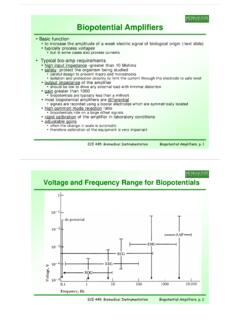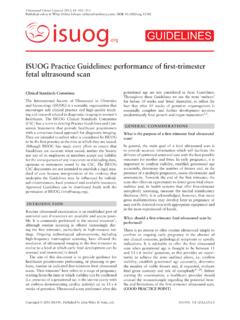Transcription of The Gross Physiology of the Cardiovascular System
1 The Gross Physiology of the Cardiovascular System Robert M. Anderson, Emeritus Associate Dean and Associate Professor of Surgery, University of Arizona College of Medicine Former Chief of Cardiothoracic Surgery, University of Arizona Medical Center Fellow of the American College of Cardiology Fellow of the American College of Surgeons Diplomate, American Board of Surgery This edition Copyright 2012 by the estate of Robert M. Anderson, MD. This text is made available under a Creative Commons Attribution-NonCommercial License.
2 It may be copied, distributed, excerpted, or adapted for noncommercial purposes so long as proper attribution is made to this original work. This text is provided for informational and educational use only, on an as-is basis, free of charge, and without receipt of any consideration by the author or publisher. Nothing contained herein is or should be considered, or used as a substitute for, medical advice, diagnosis, or treatment by professional healthcare providers. The parties involved in the preparation or publication of the text do not represent or warrant the accuracy, completeness, correctness, usefulness, or timeliness of any information contained herein.
3 They make no representations or warranties with respect to any treatment, action, or application of medication by any person following the information provided herein, and will not be liable for any direct, indirect, consequential, special, exemplary, or other damages arising therefrom. Citation for the original 1993 print version: Anderson, Robert M. The Gross Physiology of the Cardiovascular System . Tucson, AZ: Racquet Press, 1993. Print. ISBN: 0961752815 ISBN-13: 9780961752811 This text and other materials are available online at: Table of Contents Introduction 1 Chapter 1: Normal Circulation 3 Chapter 2: Abnormal Circulation 15 Chapter 3: Open Heart Surgery with Passive-Filling Pumps 22 Chapter 4: Animal Experiments with Passive-Filling Pumps 31 Chapter 5: Hydraulic Model of the Cardiovascular System 47 Summary 60 Appendix.
4 Clinical measurement of the Mean Cardiovascular Pressure 61 About the Author 63 Additional Resources 64 The Gross Physiology of the Cardiovascular System 1 Introduction At a time when knowledge about microvascular Physiology and subcellular myocardial and vascular biochemistry has accumulated at such a tremendous rate, I perceive that a realistic global understanding of the Cardiovascular System has been partially lost in that voluminous accumulation of minutiae. In order to be able to see "the forest, and not just individual leaves on the trees," one must first have a clear understanding of the Gross mechanical function of the Cardiovascular System as a whole.
5 In determining whether to replace older "sacred cows" with newer concepts, your litmus test should be the extent to which each explains observations in both normal and pathological states. Thus, a valid concept of Cardiovascular Physiology must be compatible with the following frequently overlooked facts: A blood volume equilibrium persists between the systemic and pulmonary circuits even when there are massive shunts between the two, and remains even after closure of those shunts. During cardiopulmonary bypass, the empty heart may continue to beat strongly even in the absence of any diastolic filling or stretching of the ventricles.
6 Booster pumping does not increase circulation rate in the absence of heart failure. Increasing pacemaker rate above that necessary to prevent failure does not increase cardiac output . Ventricular pressures measured during heart catheterization are always above zero (in relation to the intrathoracic pressure). 2 Introduction After heart transplantation, without nerve supply to the heart or artificial pacing, the cardiac output and pulmonary/systemic blood volume balance remain normal. In the absence of heart failure, an increase in arterial resistance does not reduce cardiac output .
7 An overall concept of Cardiovascular Physiology should accommodate these facts and all other available data. The concept presented in the following chapters explains and accommodates all of these findings. The Gross Physiology of the Cardiovascular System 3 Chapter 1: Normal Circulation The Cardiovascular System has ten unique characteristics that make it an unusually complicated hydraulic System . Understanding how the Cardiovascular System functions requires insight into a larger set of variables than that which governs the function of most pump, pipe, and fluid systems found in the world of man-made machines.
8 The ten unique characteristics peculiar to the Cardiovascular System are: 1. The System is a closed circle rather than being open-ended and linear. 2. The System is elastic rather than rigid. 3. The System is filled with liquid at a positive mean pressure ("mean Cardiovascular pressure"), which exists independent of the pumping action of the heart. 4. The right and left ventricles, which pump into the same System that they pump out of, are in series with two interposed vascular beds (systemic and pulmonary). 5. The heart fills passively, rather than by actively sucking.
9 6. As a consequence of the heart's passive filling, the circulation rate is normally regulated by peripheral-vascular factors, rather than by cardiac variables. 7. The flow from the heart is intermittent, while the flow to it is continuous. 8. Normally, there is an excess expenditure of energy by the heart needed for the circulation rate imposed by peripheral vascular regulators ("pump energy excess"). 9. Normally, ventricular capacity is in excess of the diastolic filling volume ("pump capacity excess"). 4 Chapter 1: Normal Circulation 10.
10 The slowing effect of any vascular resistance on flow rate depends on its location, with reference to upstream compliance, as well as its magnitude. In order to understand circulatory phenomena in the elastic circular hydraulic System (Fig. 1), where every point is both upstream and downstream from every other point, and where the non-sucking ventricles pump out of the same System they pump into, we need to examine the ten unique factors individually, before we can amalgamate them into a meaningful whole. Ventricles (The Pumps) To clarify and facilitate understanding of the features peculiar to the heart, it is helpful to compare three major types of pumps.






